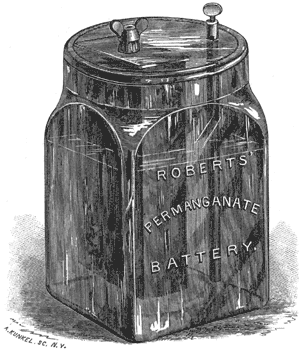[Trade Journal]
Publication: Electrical Review
New York, NY, United States
vol. 7, no. 11, p. 7, col. 2-3
The Roberts Permanganate Battery.
Previous to the invention of the well-known Leclanche, the world was practically without a commercial form of open-circuit battery. All the known forms of battery that were in use would use themselves up on an open circuit to such an extent that their frequent refilling was necessary. When a satisfactory form of open-circuit battery was given to the world, new uses and new applications presented themselves, and electricity at once found itself displacing many old mechanical contrivances which never could have been successfully replaced if the old style of cells were the only sources of electric energy to be had. Thus, the open-circuit battery found a place for itself at once, and the world would now find itself at a loss if it were asked to get along without this most useful invention.
The Roberts Permanganate Battery, here illustrated, is neatly gotten up, and, so far as externals go, it is the equal of any cell in the market. In this battery, low internal resistance can be obtained without deleterious chemical action. In this battery a radical departure has been made in the solution used to attack the zinc. Permanganate of potash is the base of the solution. The difficulties in the way of its use were enormous, and not until some thousands of experiments had been made was the present success reached. To the permanganate are added bichromate of potash and the salts of an alkali. These are dissolved in water.
 |
| New Battery of the Brevoort Manufacturing Company. |
One of the merits claimed for this cell that it is ready for work instantly as soon as the solution is made, and no vexatious delays occur between the setting up of the battery and the obtaining of its maximum of current.
Careful measurements, Mr. Roberts states, place the electromotive force of this cell at 1.7 to 1.9, and it gives about 3 amperes over its own resistance. The internal resistance is from 1/2 to 2/3 of an ohm.
These features are of great importance when it is considered that the additional strength of theRoberts battery has often been found sufficient to enable one cell to replace two sal-ammoniac cells in such work as bell-ringing; gas-lighting, annunciator work, and the like.
A very useful feature of this battery is, that the solution does not evaporate, and does not form climbing salts, which is so disagreeable, and this fact will no doubt be appreciated by electricians generally. A curious feature of this battery is, that the zinc shows so little waste when compared with the energy obtained. This may be due to the fact that the zinc is not taken into solution, but is deposited as an oxide of zinc. It may also be due to the fact that some form of electrical energy is the product of the chemical changes in the materials of the solution. These are interesting questions, but as yet no satisfactory answer can be given to them. But there have been demonstrated to the satisfaction of the inventor, that permanganate of potash being a most powerful oxidizer, and bichromate of potash second to it, are not only the cause of the depolarization in the battery, but also heighten the electro-motive force by giving up their oxygen to the nascent hydrogen of sal-ammoniac or other electrolyte, thus producing the double function of an excitant and a depolarizer, and for this reason, space for space and pound for pound this battery should be of very high efficiency and great longevity. And it is also stated as a fact, that the solution may be worked till useless and then replaced by a fresh solution, and so on for two successive charges, while the zinc element will continue to do its work and will not need replacing. When the battery has been worked till exhausted, the deep-red color of the solution changes and is succeeded by a light yellow color. This also takes place when the battery has been short-circuited for a sufficient length of time by accident, through very low resistance. In this latter event, all that is necessary is to replace the solution by a fresh one, and before doing so, to hold the lower end of the carbon in a gas flame till the ammonia is driven off, when the carbon may be replaced and practically a new battery is the result. In heating the carbon care must be taken not to melt out the soft metal connection at the top of the carbon. This cell will polarize, as must all open-circuit batteries, if used for work beyond their capacities, and which they are not fitted to do.
Another important feature in this battery is the Roberts mode of making a non-corrosive connection, which we believe to be entirely novel. This consists in forming the carbon with a hole in one end and inserting a screw therein loosely, and leaving a considerable space around said screw, and pouring around it molten alloy which will expand in cooling, thus soldering itself to the screw and expanding closely into the hole of the carbon, and making a very perfect carbon and tirm support, the end of the carbon containing the screw; and the plug thus formed is plunged into boiling parafflne and is saturated with it, and as there are no deleterious fumes in the battery the contact remains perfect.
